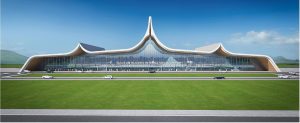Introduction
Nepal, a land of pristine beauty and cultural richness, is set on a course for transformation through a monumental contract with China. In this article, we will take an in-depth look at this historic agreement, dissecting the advantages it brings and the intricate challenges it poses for Nepal.
Nepal’s Visionary Infrastructure Project
Nepal’s dream of the Gautam Buddha International Airport signifies a profound vision. This transformative project is aimed at positioning Nepal as a global aviation hub, fostering tourism, trade, and improved connectivity. The scale of this endeavor is reflected in the extensive contract inked with China, encompassing the construction of state-of-the-art airport facilities, runways, and crucial infrastructure. The scope of this ambitious project extends far beyond a simple airport upgrade, promising to reshape Nepal’s future on the world stage.
The Fiscal Tightrope: Nepal’s Debt Dynamics
The pursuit of such an ambitious infrastructure project inevitably comes with substantial financial implications. Nepal’s national debt, a subject of concern for both policymakers and citizens, becomes particularly relevant in this context. The considerable financial commitment required for the Gautam Buddha International Airport project may exert pressure on Nepal’s fiscal resources, potentially leading to an increase in the national debt. As we progress through this article, we’ll examine the intricate financial aspects of this endeavor, evaluating whether this investment aligns with Nepal’s long-term economic objectives.

Unpacking the Contract: A Comparative Table
To facilitate a comprehensive understanding of the Nepal-China contract and the Gautam Buddha International Airport project, we present a comparative table that succinctly encapsulates the benefits and challenges:
| Aspect | Benefits | Challenges |
|---|---|---|
| Financial Impact | Increased tourism, trade, and employment. | High initial cost and debt implications. |
| Infrastructure Quality | Modern airport facilities and international connectivity. | Ensuring quality construction and management. |
| Geo-Political Relations | Strengthened ties with China. | Balancing relationships with other nations. |
Charting the Path Forward
As Nepal forges ahead with its ambitious vision, maintaining a delicate balance between the benefits and challenges is paramount. In this section, we discuss strategies that Nepal can employ to ensure the success of the Gautam Buddha International Airport project while managing its debt prudently. Practical advice for policymakers and stakeholders is provided, offering a blueprint for addressing the complexities of this massive undertaking.
Conclusion: The Art of Equilibrium
In conclusion, Nepal’s contract with China for the construction of the Gautam Buddha International Airport represents a significant leap forward in transforming its aviation sector. While the project holds the promise of increased tourism, trade, and connectivity, it simultaneously presents substantial financial challenges. Nepal’s journey to a brighter future depends on mastering the art of balance – harmonizing ambition with fiscal prudence. By effectively addressing these challenges and making well-informed decisions, Nepal can chart a course towards sustainable economic growth and development, securing the welfare of its citizens and the prosperity of the nation.




